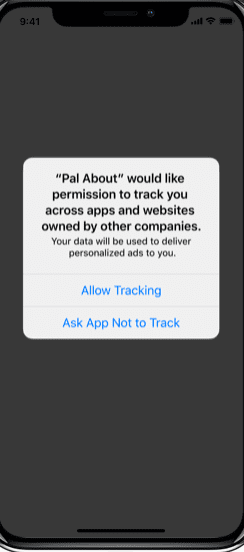Have app operators seen better days? It’s not news that anyone who runs an app and wants to collect data for marketing purposes needs the consent of their users to do so. In addition to this challenge, another issue is causing turmoil in the app business: Apple’s new privacy features in the iOS 14.5 update.
UPDATE:
The release date for the new iOS versions (iOS 14.5/iPadOS 14.5) has now been set. Starting April 26, 2021, all apps in the App Store will have to comply with iOS 14.5 requirements, according to Apple’s Developer Blog.
With this latest release, app operators must now actively ask users for their consent in order to use or decline the “Identification for Advertisers”, or IDFA (Apple’s own advertising ID). What was previously authorized factory settings (and could only be deactivated via the Settings menu) can now only be activated via an opt-in.
What does this mean? The user must now be asked directly whether their activities may be tracked by means of the IDFA in order for app operators to be able to display targeted personalized advertising. Although this may sound like the best news for data protection, it will be a nuisance for many users, and poses a whole new challenge to the app industry. But why?
Would you like to be tracked by your app? Probably not!
Imagine this: a user downloads a new app and before even launching it and the first question asked via a pop-up is, “Do you want to be tracked by this app?” Few would say yes, and with a single click they would decide against sharing their personal data (or, more precisely, against using their IDFA).
What this response – and the accompanying loss of data – means for the business model used by a large part of the app industry is clear. When it comes to app tracking for marketing purposes, nothing is possible without the user’s consent.
“Consent is gold” is the latest saying among online marketers. If consent is worth this much, is it possible to obtain it in an appealing way? How do you build necessary user trust so that they provide consent to the use of their personal data for marketing purposes?
This is where the trade-off comes in: added value, services and goodies in exchange for – you got it – consent.
Whether users give their consent depends on various factors, which can nonetheless be summed up by two words: “trust” and “value”. Users that trust the company that is requesting their consent will be more likely to opt in. To build trust you need to show your users the value you are giving back to them in exchange for their personal information.
But let’s be honest. Even the most in-demand app from trusted providers will have to expect a significant drop in the opt-in rate due to the new iOS14.5 ATT mode. There are hardly any statistics on this so far, but an optimistic view would project an opt-in rate in the range of 50-70%. But there’s also some data showing that opt-in rates of 10-20% are much more realistic. In the Gaming – Hyper Casual category, where the user tends not to know the developer behind the game, is likely to be the most impacted: a recent report published by AppsFlyer shows an average of only a 12% opt-in rate for Gaming – Hyper Casual category apps.
Not exactly a promising outlook that will make app developers say “Hip hip hurray!” But as challenging as it may seem, you’re not alone. The issue affects the entire industry. Therefore, those that act as quickly as possible in collecting app consent will not only increase their opt-in rates (and thus their ad revenue), but will also gain a competitive advantage in the industry.
Best Practices for App Developers and Publishers: how to optimize the consent opt-in rate in the right way?
1. Take ownership of the flow – prepare your user for the ATT pop-up
Important to remember: when asking for consent, when and how have a decisive influence on the opt-in rate.
If users are prepared for what is to come, the more likely they are to give consent to the use of their data. Before the ATT pop-up appears on the app, you need to build trust and show value to your users.
You can do that by creating pre-prompt screens, explaining to your users why their “yes” is important to your business, what they get in return (e.g. delivering personalized ads vs. generic ads, or a free game), and how you are going to use their data.
Our tip: A Consent Management Platform is the right solution to create an appealing and personalized pre-prompt banner that – at the same time – fully integrates all necessary steps required to be compliant with various legislation like GDPR.
2. Display the ATT pop-up second
Users have been notified so they know what’s coming next, making this the right time to show the ATT banner. Just so you know, the ATT pop-up cannot be customized or changed by the user, except for the short line that explains why the app wants to track the user. Also, it only offers two options: accept or reject.

Apple-IDFA-Consent-Banner
The Apple ATT-consent banner: app operators only have the option to adjust the text of the line “Your data…”. The rest of the banner text and design cannot be changed.
3. Make sure your app is compliant with privacy regulations
The consent that Apple now requires as part of its App Tracking Transparency Framework (ATT) is not compliant with GDPR. Therefore it does not replace a Consent Management Platform (CMP). This means that in order to be legally compliant, general consent for data use must be obtained in addition to ATT consent.
The problem here is clear: before the app visitor can even use the app, they would have already been asked for consent twice via pop-up banners. So what can be done to prevent this scenario from ending in click fatigue and annoyed opt-outs?
This is where you need a Consent Management Platform that is able to work closely with you to integrate iOS requirements and legal framework requirements in a seamless way.
A CMP will respect your user experience, help you to build trust and communicate value to your users.
The iOS App Tracking Transparency framework poses new challenges to the Mobile Apps industry. Companies will have to double down on their efforts to build trust with their users and communicate the value offered to them.
A privacy revolution is coming to the mobile industry, driven by regulators and users, who more and more demand more transparency from companies. A recent Deloitte report states that 40% of users interviewed in the last year decided to delete an app due to privacy concerns.
The Mobile Apps industry has been called to the challenge of providing more transparency to users while at the same time providing an optimal user experience to app users and preserving their LTV. All while ensuring full compliance with dynamic privacy regulations that are being implemented in more and more countries.
This is where a Consent Management Platform (CMP) that is fully customizable, adapted to any user journey, and able to provide full compliance with any privacy regulation can help.
At Usercentrics we have a strong focus on mobile apps with a dedicated solution for app developers.
Would you like to learn more about mobile app consent management and explore our in-app consent management solution?
You can find all the information here.
